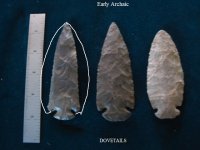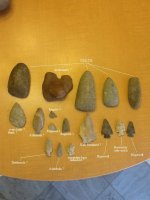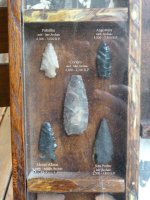I'm back, haven't forgotten all of you, and my promise.
LostInTheOzone. Here's what I think you have:
Of course my opinion is open for debate, I've certainly no monopoly on the truth regarding this subject, but then, neither does anybody else. I wish somebody did, because it'd clear up a bunch of mysteries, and create new ones.
The "coolest" point in your group is the Angostura, if indeed it is one, and it sure looks like one. Angostura's have absolutely exquisite flaking technique and pattern, they're always made from extremely high quality material, often as not, obsidian. Look at the flaking pattern, compare it to that seen on your other points, you SHOULD see an obvious difference, if indeed it is an Angostura. It'd be kind of small for the type, but the proportions are absolutely Angosturan, so is the material, so is the location of the find. Again, see if you can discern an absolute difference in the flaking style, as opposed to that seen on your other points.
The large point, in the center of the picture, looks like a Cortero, and has provenance, Cathedral Cave. A girl by the name of Cristin Embree is much involved at Cathedral Cave, it's the subject of her doctoral dissertation, Northern Arizona University (?). You should send her an e-mail, regarding your point, because it's another "data point" and she can note the material, and exact style, etc.
Hope this was helpful....beautiful little Angostura (?)


























